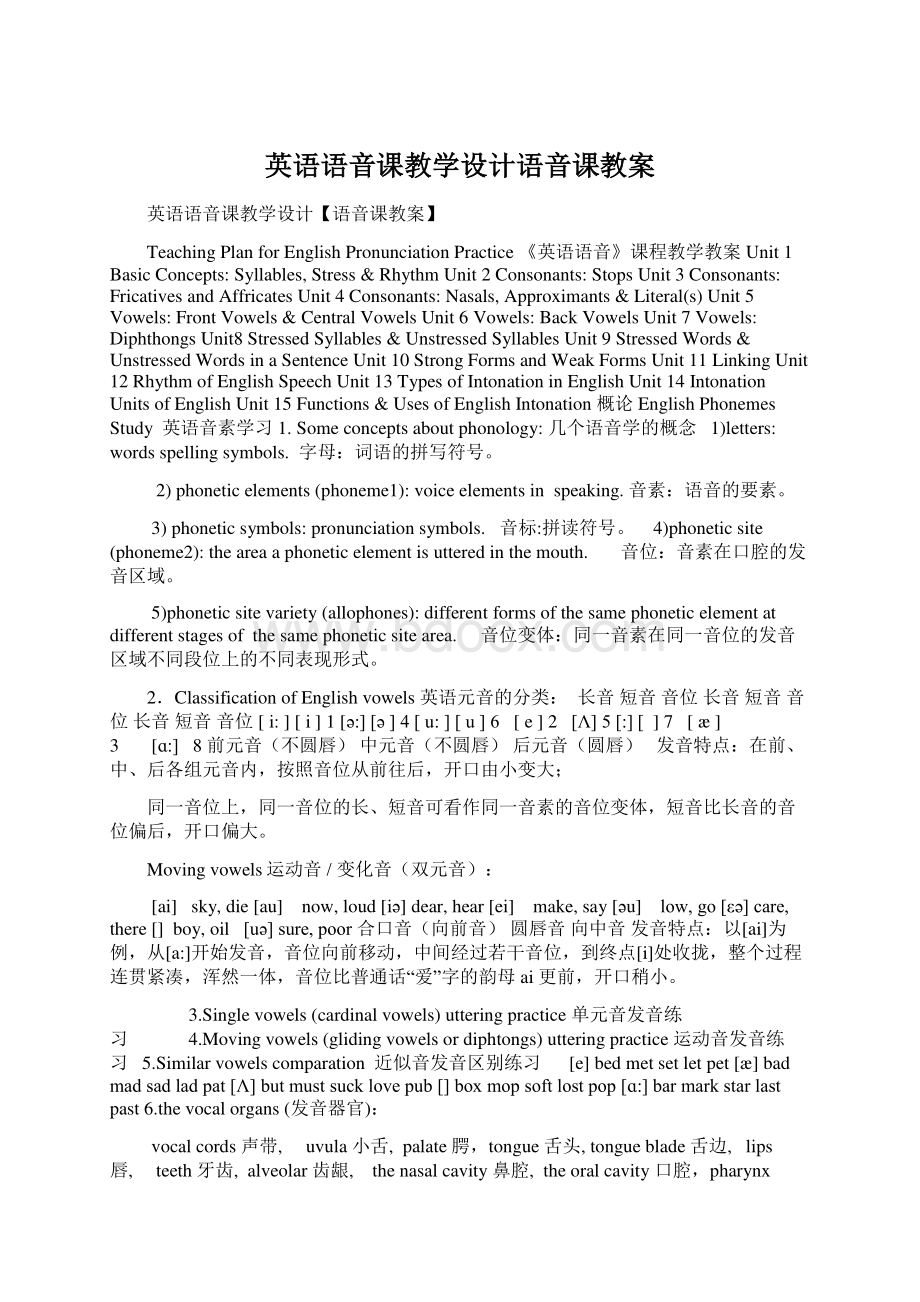英语语音课教学设计语音课教案.docx
《英语语音课教学设计语音课教案.docx》由会员分享,可在线阅读,更多相关《英语语音课教学设计语音课教案.docx(37页珍藏版)》请在冰豆网上搜索。

英语语音课教学设计语音课教案英语语音课教学设计语音课教案英语语音课教学设计【语音课教案】TeachingPlanforEnglishPronunciationPractice英语语音课程教学教案Unit1BasicConcepts:
Syllables,Stress&RhythmUnit2Consonants:
StopsUnit3Consonants:
FricativesandAffricatesUnit4Consonants:
Nasals,Approximants&Literal(s)Unit5Vowels:
FrontVowels&CentralVowelsUnit6Vowels:
BackVowelsUnit7Vowels:
DiphthongsUnit8StressedSyllables&UnstressedSyllablesUnit9StressedWords&UnstressedWordsinaSentenceUnit10StrongFormsandWeakFormsUnit11LinkingUnit12RhythmofEnglishSpeechUnit13TypesofIntonationinEnglishUnit14IntonationUnitsofEnglishUnit15Functions&UsesofEnglishIntonation概论EnglishPhonemesStudy英语音素学习1.Someconceptsaboutphonology:
几个语音学的概念1)letters:
wordsspellingsymbols.字母:
词语的拼写符号。
2)phoneticelements(phoneme1):
voiceelementsinspeaking.音素:
语音的要素。
3)phoneticsymbols:
pronunciationsymbols.音标:
拼读符号。
4)phoneticsite(phoneme2):
theareaaphoneticelementisutteredinthemouth.音位:
音素在口腔的发音区域。
5)phoneticsitevariety(allophones):
differentformsofthesamephoneticelementatdifferentstagesofthesamephoneticsitearea.音位变体:
同一音素在同一音位的发音区域不同段位上的不同表现形式。
2ClassificationofEnglishvowels英语元音的分类:
长音短音音位长音短音音位长音短音音位i:
i1:
4u:
u6e25:
73:
8前元音(不圆唇)中元音(不圆唇)后元音(圆唇)发音特点:
在前、中、后各组元音内,按照音位从前往后,开口由小变大;同一音位上,同一音位的长、短音可看作同一音素的音位变体,短音比长音的音位偏后,开口偏大。
Movingvowels运动音/变化音(双元音):
aisky,dieaunow,loudidear,heareimake,sayulow,gocare,thereboy,oilusure,poor合口音(向前音)圆唇音向中音发音特点:
以ai为例,从a:
开始发音,音位向前移动,中间经过若干音位,到终点i处收拢,整个过程连贯紧凑,浑然一体,音位比普通话“爱”字的韵母ai更前,开口稍小。
3.Singlevowels(cardinalvowels)utteringpractice单元音发音练习4.Movingvowels(glidingvowelsordiphtongs)utteringpractice运动音发音练习5.Similarvowelscomparation近似音发音区别练习ebedmetsetletpetbadmadsadladpatbutmustsucklovepubboxmopsoftlostpop:
barmarkstarlastpast6.thevocalorgans(发音器官):
vocalcords声带,uvula小舌,palate腭,tongue舌头,tongueblade舌边,lips唇,teeth牙齿,alveolar齿龈,thenasalcavity鼻腔,theoralcavity口腔,pharynx咽,larynx喉Theconsonantselementsstudy辅音音素学习I.theconstructureoftheEnglishconsonants英语辅音构成1.
(1)清辅音:
发音时声带不振动的辅音;
(2)浊辅音:
发音时声带要振动的辅音。
2.爆破音plosiveconsonants:
ptk;bdg;摩擦音fricativeconsonants:
sf;zv;hr鼻音nasalconsonants:
mn;舌边音(旁流音)lateralconsonants:
l;半元音semi-vowels:
jw;破擦音affricateconsonants:
tstdzdtrdr.II.phoneticpractice发音练习IIIhardpointsexplaination难点解说:
shy,show,sharp;汉语拼音sh(施)x(西):
先定好发“施”的翘舌动作,在上齿后部发出“西”音,然后去除“xi”的韵母。
:
pleasure,usual汉语拼音r(日)y(衣)t:
change,teach汉语拼音ch(吃)q(七);d:
charge,danger汉语拼音zh(智)j(机)IV.Englishtonguetwisterpractice英语绕口令练习:
1.Shesellstheshellsatthesea-shore,andtheshellsshesellsaresea-shells,Imsure.Causeshesellstheshellsonthesea-shore,theshellsshesellsaresea-shellsforsure.2.PeterPiperpickedapackofpickledpeppers.IfPeterPiperpickedapackofpickledpeppers,howmanypickledpeppersdidPeterPiperpick?
VI.interestingnumbersreciltingpractice趣味数字背诵练习:
用“流水诵记法”背诵一百位圆周率小数目的:
通过这一练习,使学生体验语音节律和联想对记忆的强化和整合作用,使较长的记忆单元变为一个有机的整体,熟练后可达到一气呵成的功效。
一口气背完一百位圆周率小数最快仅7秒。
=3.1415926535897932834626433382975028841971693993751058209749445923078164062862089986280348253421170679英语音标教学中非拉丁字母的符号如何输入?
方法一、插入字符。
在word中,不同字体的字符容量是不同的,MicrosoftRereranceSansSerif等字体包含了非拉丁字母的其他国际音标符号。
输入方法如下:
使用“插入”“符号”“字体”选择:
1、MicrosoftRereranceSansSerif:
d2、“MsGothic”:
:
3、“MsMincho”:
:
4、“LucidaSansUnicode”:
方法二:
利用在线服务输入,复制并粘贴到word上。
网址:
1、:
利用网络上的英语音标在线学习网页。
网址:
1、:
利用网络在线词典,查出单词的注音,复制并粘贴到word上。
在线词典:
GigaMedia,Taiwan在线英汉词典:
Merriam-WebsterOn-lineDictionary:
将这些音标复制下来,保存为一个专门的文档,要用时就复制过去。
:
音位标记(中括号):
长音符号:
重音符号:
次重音符号:
元音:
辅音:
说明:
网页上出现的方框”,表明该网页的显示字体库中没有相应字符,无法正常显示.Unit1LessonPlanBasicConcepts:
Syllables,Stress&Rhythm(教案:
附要点、重点和难点)Date:
Sept.16-20Class:
Classes1,2&3,Grade2002Subject:
EnglishPronunciationPracticePurpose:
ThestudentswilllearnsomebasicconceptsinEnglishpronunciation.Wearegoingtolearnsomethingaboutsyllables,stressandrhythminEnglish.Atthesametime,theywilllearntosaygreetingsandfarewellwithappropriatepronunciationandintonationinEnglish.Objectives:
Studentswillbeableto:
1.Define-intheirownwordsadefinitionfor“syllable”and“stressedsyllable”,thenadefinitionfor“rhythm”and“rhythmicpattern”;2.Comparebasedontheunderstandingofthebasicconcept,comparethedegreesofstressanddifferentrhythmicpatterns;3.PracticeimitatethetypicalstresspatternsandrhythmicpatternsinEnglish.Resources/Materials:
1.Textbook:
Wang,Guizhen,AnEnglishPronunciationCourse,HigherEducationPress,Beijing,2000;2.Handouts:
illustrationofstresspatternsandrhythmicpattern;3.RecordingsofnativespeakersActivitiesandProcedures:
1.BeginbyaskingtheclasstofindouthowmuchthestudentsknowaboutstresspatternsandrhythmicpattersinEnglish,makesurethatitservesthepurposeofstimulatingthestudentstothinkabouttheissueandhavethedesiretofindouttheanswersthemselves.2.DisplayexamplesbyplayingtherecordingofthenativespeakersshowingthetypicalstresspattersandrhythmicpatternsinEnglish.3.Askthestudentstolistentothetapestomarkoutthestressedsyllablesinwords.4.Askthestudentstolistentothetapestomarkoutthestressedwordsinsentences.5.Havethestudentsimitatethestresspatternsandrhythmicpatternstoexperiencetherhythminspeech.6.Havethestudentssharewhattheyhavelearnedbyreadingoutthepracticematerialsinpairs.7.HavethestudentslistentotheconversationsrecordedbynativespeakersofEnglishandtrytogettherhythmicpatternsintheirspeech.8.Havethestudentspracticetheguidedconversation.Askthemtopayspecialattentiontothestresstherhythminspeech.9.Highlightthelanguagefunctionintheconversationinthepractice.10.Haveseveralpairsofthestudentspresenttheirconversationintheclass.11.Commentonthestudentsperformancebyhighlightingtheachievementofthestudentsandtheeffortstheyneedfortheimprovement.12.Askthestudentstodomorepracticeafterclassandgetreadyforpresentationduringthenextsession.附:
要点、重点和难点Unit1BasicConcepts:
Syllables,Stress&RhythmInthisunit,wearegoingtolearnsomebasicconceptsinEnglishpronunciation.Wearegoingtolearnsomethingaboutsyllables,stressandrhythminEnglish.Atthesametime,wearegoingtolearntosaygreetingsandfarewellwithappropriatepronunciationandintonationinEnglish.Firstofall,letslookatthesyllableinEnglish.Pleaselistentothefollowingword:
driveway.Now,tellme,howmanysyllablesthereareinthisword?
Right.Therearetwo.Pleaselistentothefollowingsentence:
Drivehimaway.Tellme,howmanysyllablesthereareinthissentence?
Right.Therearefour.IntroductionSo.Whatisasyllable?
AsyllableisawordpartandthebasicunitofEnglishrhythm.Englishwordscanhaveone,two,threeorevenmoresyllables.Intheworddriveway,therearetwosyllables.InthesentenceDrivehimaway,therearefour.Whatisastressedsyllable?
InEnglishwordswithmorethanonesyllable,oneofthemwillreceivemorestressthantheothers.Stressedsyllablesarethosethataremarkedinthedictionaryasstressed.Forexample,intheworddriveway,thefirstsyllableisastressedsyllablewhilethesecondsyllableisnot.StressedsyllablesinEnglishareusuallylonger,louder,andhigherinpitch.Listentothefollowingexample:
baNAAAAnaSyllable1Syllable2Syllable3(short)(long)(short)Theword“banana”has3syllables.Syllable1isnotstressedandsoisshort.Syllable2isstressedandsoislongwithaclearvowelsound/B:
/.Syllable3isnotstressedandsoisalsoshort.Hereisashortsummaryaboutthestressedandunstressedsyllables:
Stressedsyllablesarestrongsyllables.Unstressedsyllablesareweaksyllables.Stressedsyllables:
-arelong-haveapitchchange-havefullvowelsounds.Unstressedsyllables:
-areshort-oftenhaveareducedvowelsound.NowletslookattherhythminEnglish.WeallknowthatcorrectpronunciationoftheindividualEnglishsoundsisimportantincommunication.Thewaythesoundsareorganized,however,isoftenmorecrucialforunderstanding.TherhythmofEnglish,forexample,isoneofthetwomajororganizingstructuresthatnativespeakersrelyontoprocessspeech.Whatisrhythm?
Rhythmcanbefoundeverywhereinlife:
thesoundofaclock,thebeatingoftheheart,thestrokesofaswimmer,andofcourseinpoetryandmusic.Butrhythminlanguageislessfamiliarbecauseitislessobvious.Therhythmofalanguageischaracterizedbythetimingpatternofsuccessivesyllables.Insomelanguages,everysyllableisgivenaboutthesamelength,whileinothers,syllablesvaryinlength.InEnglish,strongbeatsarecalledstress-theheartoftherhythmicpattern.第1单元基本概念:
音节、重音与节奏本单元将向大家介绍英语语音语调的基本概念,主要介绍英语语音的音节、重音和节奏规律。
首先,让我们先来看看英语的音节:
单词driveway有两个音节。
句子Drivehimaway有四个音节。
何谓“音节”?
音节是一个言语单位,常常比一个语音长,但比一个单词短。
一个英语单词可以有一个、两个三个或更多的音节。
就像我们刚看到的单词driveway有两个音节,句子Drivehimaway有四个音节。
同时,音节又是英语发音节奏的最基本的单位。
何谓“重读音节”?
如果一个英语单词中拥有两个或两个以上的音节,其中一个音节会比其周围的音节要响亮些。
重读音节通常在词典中有所标注。
例如,单词driveway的第一个音节就是重读音节,而它的第二个音节就是非重读音节。
英语中的重读音节在发音过程中往往要比非重读音节要长一些,响亮一些,同时音调也稍高一些。
例如,“banana”一词有三个音节。
第一个音节是非重音,所以发音所需时间比较短。
第二个音节是重读,所以元音/B:
/发的比较长,清晰响亮。
第三个音节同样属非重音,所以发音所需时间也很短。
可见,重读音节与非重读音节分别有以下特征:
重读音节:
声音响亮延续时间较长音调较高非重读音节:
1.延续时间较短2.元音发音弱化英语话语节奏:
学会发好每一个英语音素,是学好英语语音的基础,正确的发音在语言交流中非常重要。
然而,语音的组合方式对于听者的理解也起着至关重要的作用。
英语的话语节奏就是其中之一。
何谓“英语话语节奏”?
节奏在我们的日常生活中无所不在:
滴答转动的钟表声,砰砰不停的心脏跳动,游泳的划水节拍,优美诗句和音乐的韵律,这些都是节奏的体现。
话语节奏与前面我们所提到的日常生活中显而易见的节奏不同之处在于:
语言中的话语节奏不是那么明显与绝对。
语言中的节奏特征是由一连串音节的长短来体现的。
有一些语言的话语特点是:
每一个音节的音长呈大致相同的趋势,这种音节彼此距离大致相等的现象被称为“以音节定时”节奏。
汉语的话语节奏就有这样的倾向。
例如,当我说:
“面包加牛奶”,这里含5个音节,所需的时间暂且定为5个时段。
如果我要说:
“一片面包加一杯牛奶”,这里含9个音节,所需的时间就是9个时段。
英语的话语节奏则显不同的趋势。
例如,在“breadandmilk”短语中,音节数是三个,其中“bread”与“milk”是重读音节。
在“somebreadandsomemilk”这一短语中,音节数是5个,其中重读的也是“bread”与“milk”。
虽然这两个短语的音节数不同,但是在话语中,它们所需的时间却是大致相同的,因为它们有一个共同点:
重读音节数相同。
这种重读音节彼此距离相等的现象就是“以重音定时”节奏。
掌握这一英语话语的节奏规律。
对于提高我们英语口语的流利程度和自然程度以及英语听力理解快速解码的能力至关重要。
正因为